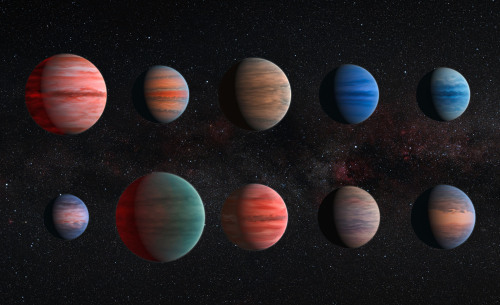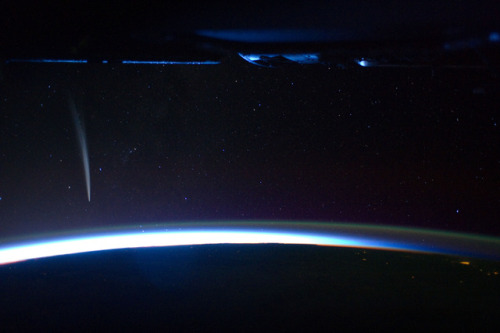Saturn Photographed By The Cassini Spacecraft In 2014

Saturn photographed by the Cassini spacecraft in 2014
Image credit: NASA/JPL/Cassini; precessed by: Ian Regan
More Posts from Xyhor-astronomy and Others
Cassini Mission: What’s Next?
It’s Friday, Sept. 15 and our Cassini mission has officially come to a spectacular end. The final signal from the spacecraft was received here on Earth at 7:55 a.m. EDT after a fateful plunge into Saturn’s atmosphere.

After losing contact with Earth, the spacecraft burned up like a meteor, becoming part of the planet itself.

Although bittersweet, Cassini’s triumphant end is the culmination of a nearly 20-year mission that overflowed with discoveries.
But, what happens now?
Mission Team and Data
Now that the spacecraft is gone, most of the team’s engineers are migrating to other planetary missions, where they will continue to contribute to the work we’re doing to explore our solar system and beyond.

Mission scientists will keep working for the coming years to ensure that we fully understand all of the data acquired during the mission’s Grand Finale. They will carefully calibrate and study all of this data so that it can be entered into the Planetary Data System. From there, it will be accessible to future scientists for years to come.

Even beyond that, the science data will continue to be worked on for decades, possibly more, depending on the research grants that are acquired.
Other team members, some who have spent most of their career working on the Cassini mission, will use this as an opportunity to retire.
Future Missions
In revealing that Enceladus has essentially all the ingredients needed for life, the mission energized a pivot to the exploration of “ocean worlds” that has been sweeping planetary science over the past couple of decades.

Jupiter’s moon Europa has been a prime target for future exploration, and many lessons during Cassini’s mission are being applied in planning our Europa Clipper mission, planned for launch in the 2020s.

The mission will orbit the giant planet, Jupiter, using gravitational assists from large moons to maneuver the spacecraft into repeated close encounters, much as Cassini has used the gravity of Titan to continually shape the spacecraft’s course.
In addition, many engineers and scientists from Cassini are serving on the new Europa Clipper mission and helping to shape its science investigations. For example, several members of the Cassini Ion and Neutral Mass Spectrometer team are developing an extremely sensitive, next-generation version of their instrument for flight on Europa Clipper. What Cassini has learned about flying through the plume of material spraying from Enceladus will be invaluable to Europa Clipper, should plume activity be confirmed on Europa.

In the decades following Cassini, scientists hope to return to the Saturn system to follow up on the mission’s many discoveries. Mission concepts under consideration include robotic explorers to drift on the methane seas of Titan and fly through the Enceladus plume to collect and analyze samples for signs of biology.

Atmospheric probes to all four of the outer planets have long been a priority for the science community, and the most recent recommendations from a group of planetary scientists shows interest in sending such a mission to Saturn. By directly sampling Saturn’s upper atmosphere during its last orbits and final plunge, Cassini is laying the groundwork for an potential Saturn atmospheric probe.

A variety of potential mission concepts are discussed in a recently completed study — including orbiters, flybys and probes that would dive into Uranus’ atmosphere to study its composition. Future missions to the ice giants might explore those worlds using an approach similar to Cassini’s mission.
Learn more about the Cassini mission and its Grand Finale HERE.
Follow the mission on Facebook and Twitter for the latest updates.
Make sure to follow us on Tumblr for your regular dose of space: http://nasa.tumblr.com.
Space Station flight from a clear North Africa over a story Mediterranean

Shadow Veil by Abi Ashra (Tumblr)

Enceladus, moon of Saturn, observed by the Voyager 2 space probe on August 26, 1981, from a distance of approximately 109,000 kilometers.
(Planetary Society)

This image shows an artist’s impression of the 10 Hot Jupiter Exoplanets studied using the Hubble and Spitzer Space Telescopes. From the upper left to the lower right corner, these planets are WASP-12b, WASP-6b, WASP-31b, WASP-39b, HD 189733b, HAT-P-12b, WASP-17b, WASP-19b, HAT-P-1b And HD 209458b.
Credit: ESA / Hubble & NASA
Low genetic diversity is a problem when you’re founding a new colony, so how would we avoid that on another planet?

The Comet and the Star Cluster : Comet Linear has become unexpectedly bright. The comet, discovered in 2000, underwent a 100-fold outburst just a week before it passed a mere 14 lunar distances from Earth late last month. The comet was captured here last week at about magnitude 6 just bright enough to be seen by the unaided eye passing in front of the distant globular star cluster M14. Comet 252/P LINEAR is one of a rare group of comets that vacillate between the Earth and Jupiter every 5 years. How the comet will evolve from here is unknown, but hopes run high that it will remain a good object for binoculars in northern skies for the next week or two. via NASA
js
Take in the Surreal Beauty of Jupiter in These Incredible New Images NASA released the raw data earlier this week, allowing the public to process the beautiful images

Comet Lovejoy is visible near Earth’s horizon in this nighttime image photographed by NASA astronaut Dan Burbank, Expedition 30 commander, onboard the International Space Station on Dec. 21, 2011.
Image credit: NASA
-
 intusion liked this · 5 months ago
intusion liked this · 5 months ago -
 wandering-cynic reblogged this · 5 months ago
wandering-cynic reblogged this · 5 months ago -
 selena-niord liked this · 5 months ago
selena-niord liked this · 5 months ago -
 thedogs99 liked this · 5 months ago
thedogs99 liked this · 5 months ago -
 shannybangbang reblogged this · 5 months ago
shannybangbang reblogged this · 5 months ago -
 archiviotemporaneo reblogged this · 6 months ago
archiviotemporaneo reblogged this · 6 months ago -
 whykellothere reblogged this · 6 months ago
whykellothere reblogged this · 6 months ago -
 foolishhit reblogged this · 7 months ago
foolishhit reblogged this · 7 months ago -
 bouncehousedemons liked this · 7 months ago
bouncehousedemons liked this · 7 months ago -
 starvulture reblogged this · 7 months ago
starvulture reblogged this · 7 months ago -
 void-crow reblogged this · 7 months ago
void-crow reblogged this · 7 months ago -
 nessieac liked this · 7 months ago
nessieac liked this · 7 months ago -
 iwillruletheuniverse reblogged this · 7 months ago
iwillruletheuniverse reblogged this · 7 months ago -
 ohfallingstar reblogged this · 7 months ago
ohfallingstar reblogged this · 7 months ago -
 mercurialmagic reblogged this · 7 months ago
mercurialmagic reblogged this · 7 months ago -
 mossworldsstuff reblogged this · 8 months ago
mossworldsstuff reblogged this · 8 months ago -
 mossworldsstuff liked this · 8 months ago
mossworldsstuff liked this · 8 months ago -
 dahliasgloom reblogged this · 8 months ago
dahliasgloom reblogged this · 8 months ago -
 discofightsandpuppies reblogged this · 8 months ago
discofightsandpuppies reblogged this · 8 months ago -
 discofightsandpuppies liked this · 8 months ago
discofightsandpuppies liked this · 8 months ago -
 your-mommy-ems liked this · 8 months ago
your-mommy-ems liked this · 8 months ago -
 minowly liked this · 8 months ago
minowly liked this · 8 months ago -
 lily-of-elysium liked this · 8 months ago
lily-of-elysium liked this · 8 months ago -
 drflywheel liked this · 8 months ago
drflywheel liked this · 8 months ago -
 silvertrees liked this · 8 months ago
silvertrees liked this · 8 months ago -
 wtfatma reblogged this · 8 months ago
wtfatma reblogged this · 8 months ago -
 stubbornbliss liked this · 8 months ago
stubbornbliss liked this · 8 months ago -
 96skid reblogged this · 8 months ago
96skid reblogged this · 8 months ago -
 hxress23 liked this · 8 months ago
hxress23 liked this · 8 months ago -
 cum-mywae liked this · 8 months ago
cum-mywae liked this · 8 months ago -
 notasaintq reblogged this · 8 months ago
notasaintq reblogged this · 8 months ago -
 the-last-odyssey reblogged this · 8 months ago
the-last-odyssey reblogged this · 8 months ago -
 gardenof-l-i-l-i-t-h reblogged this · 8 months ago
gardenof-l-i-l-i-t-h reblogged this · 8 months ago -
 exoticlulu69 reblogged this · 8 months ago
exoticlulu69 reblogged this · 8 months ago -
 lovelenanicole reblogged this · 8 months ago
lovelenanicole reblogged this · 8 months ago -
 lovelenanicole liked this · 8 months ago
lovelenanicole liked this · 8 months ago -
 maeganbobaegan liked this · 8 months ago
maeganbobaegan liked this · 8 months ago -
 bibicancer liked this · 8 months ago
bibicancer liked this · 8 months ago -
 02000 reblogged this · 8 months ago
02000 reblogged this · 8 months ago -
 02000 liked this · 8 months ago
02000 liked this · 8 months ago -
 waternymph55 liked this · 8 months ago
waternymph55 liked this · 8 months ago -
 waternymph55 reblogged this · 8 months ago
waternymph55 reblogged this · 8 months ago -
 glycerinequeenxx liked this · 8 months ago
glycerinequeenxx liked this · 8 months ago -
 area--52 reblogged this · 8 months ago
area--52 reblogged this · 8 months ago -
 mercurialmagic liked this · 8 months ago
mercurialmagic liked this · 8 months ago -
 area--52 liked this · 8 months ago
area--52 liked this · 8 months ago
For more content, Click Here and experience this XYHor in its entirety!Space...the Final Frontier. Let's boldly go where few have gone before with XYHor: Space: Astronomy & Spacefaring: the collection of the latest finds and science behind exploring our solar system, how we'll get there and what we need to be prepared for!
128 posts